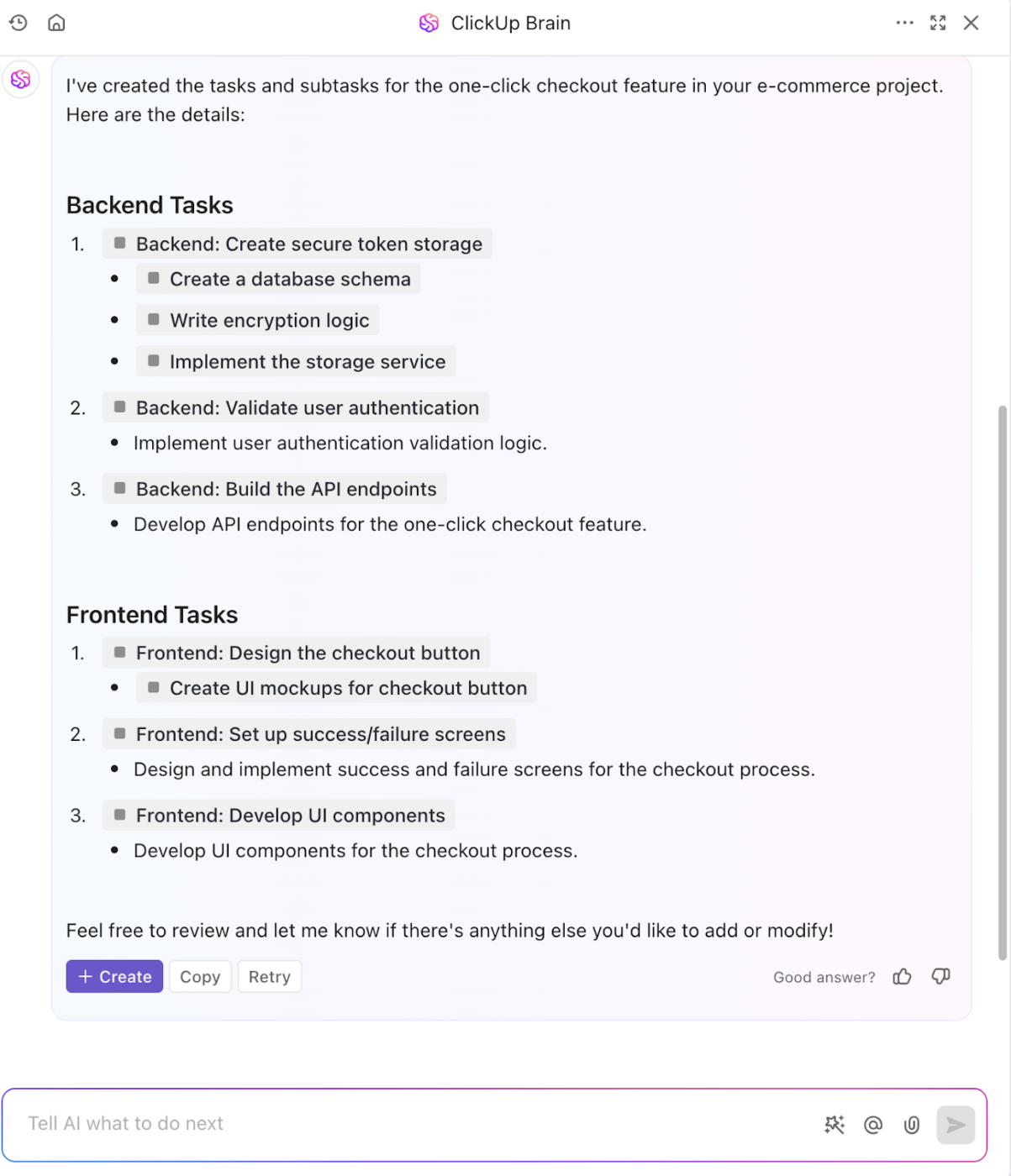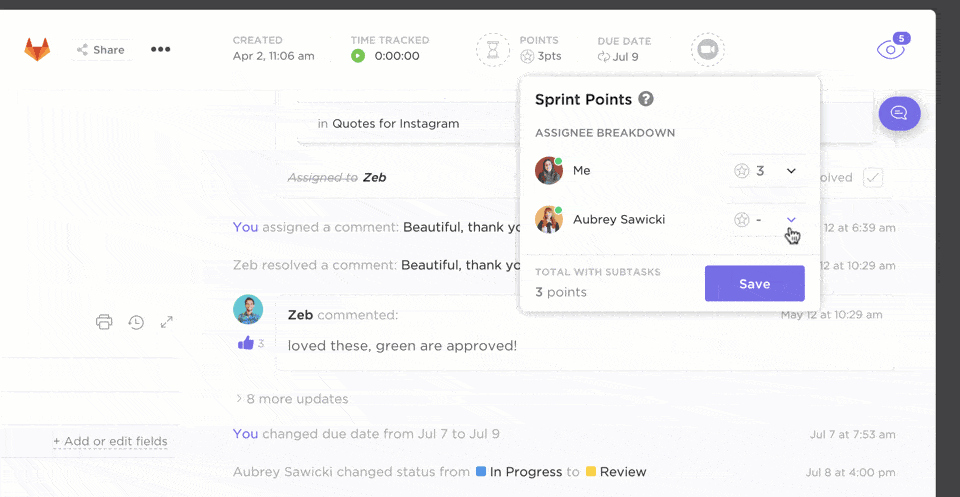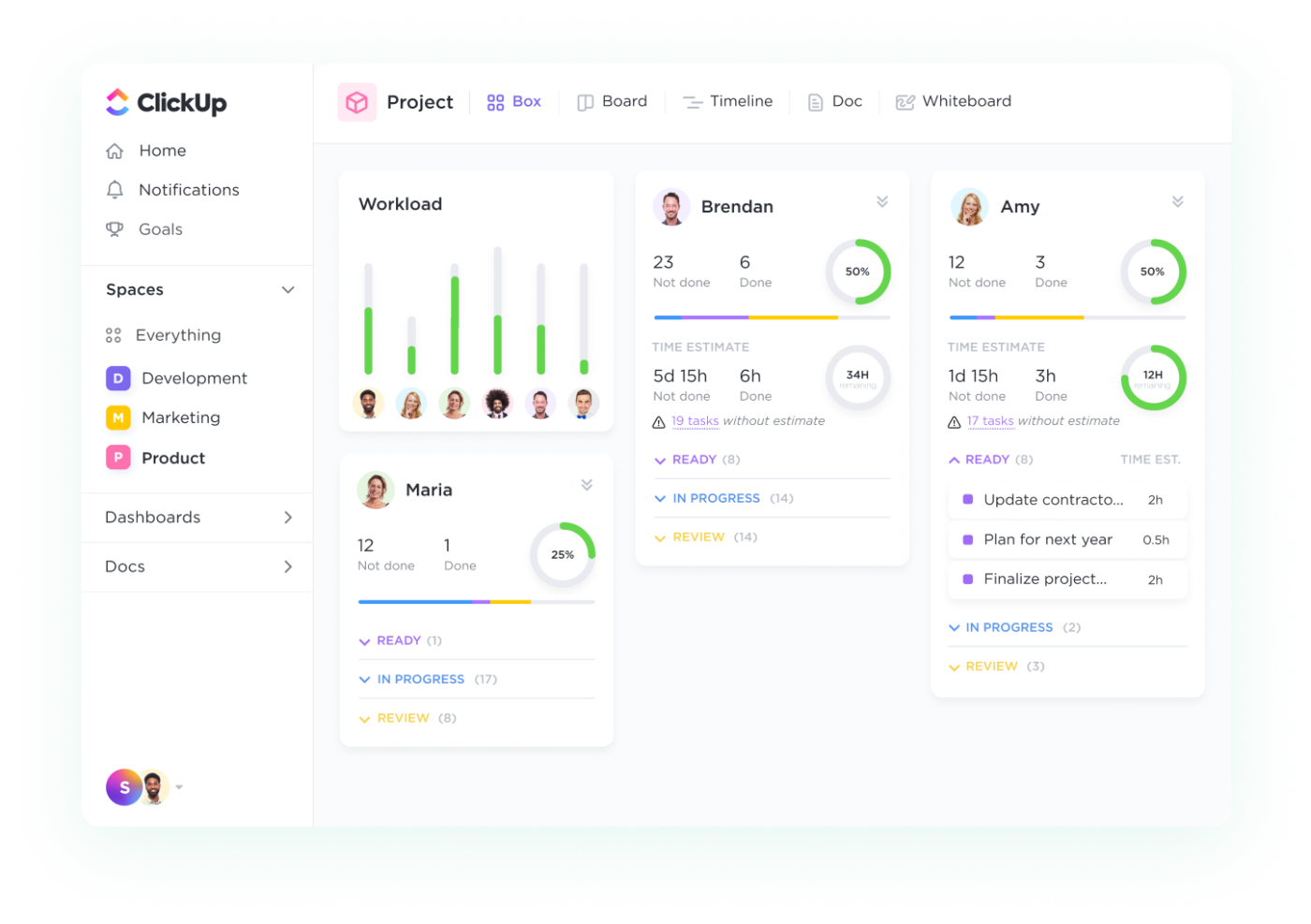It’s easy to feel overwhelmed by a massive project. As tasks pile up, teams can lose focus, slow down, and see a dip in work quality.
But there’s a popular solution—94% of the 127 companies surveyed by the Boston Consulting Group globally have adopted the Agile methodology.
With Agile’s Scrum framework, massive projects become bite-sized sprints—keeping teams focused and progress steady. Each sprint is a stepping stone, getting you closer to your goal.
But how do you decide what to work on in each sprint? Enter the sprint backlog—your game plan for turning chaos into clarity.
In this blog post, we’ll explore sprint backlogs: what they are, why they’re important, and how to create and manage one using ClickUp.
- ⏰60-Second Summary
- What Is a Sprint Backlog?
- Understanding the Sprint Backlog
- The Role of a Sprint Backlog in Scrum
- How to Create a Sprint Backlog
- Best Practices for Using a Sprint Backlog
- Challenges in Sprint Backlog Management and How to Overcome Them
- Build and Manage Your Sprint Backlogs with Clickup for Maximum Success
⏰60-Second Summary
You can create a sprint backlog using the following steps:
- Organize your product backlog: Prioritize tasks based on value and importance for the sprint
- Set a clear sprint goal and focus on priorities: Define a clear objective and select tasks that contribute to achieving it
- Know your team’s capacity: Assess your team’s available resources and how much work they can handle
- Break big tasks into small, manageable steps: Divide large tasks into smaller, actionable pieces for easier management
- Create your sprint dashboard: Set up a project management tool like ClickUp to track tasks, progress, and team performance
- Finalize the plan and get your team aligned: Review and confirm the plan with your team and make sure everyone knows what to do
What Is a Sprint Backlog?
A sprint backlog is a simple list of tasks your Scrum team plans to finish during a sprint, usually lasting 2-4 weeks. It also represents what the developers plan to accomplish during the sprint.
It’s like a to-do list for the sprint, broken into clear, actionable plans and manageable steps.
For example, if you’re working on a mobile app, your sprint backlog items might include:
- Design the user profile screen (8 hours)
- Add login functionality (16 hours)
- Set up a database for user data (12 hours)
- Write tests for login features (6 hours)
Each task is estimated and prioritized so your team can stay focused and track progress easily.
➡️ Also Read: How Can Scrum Techniques Improve Project Delivery
Understanding the Sprint Backlog
A sprint backlog provides clarity, ownership, and accountability so everyone knows what they’re working on and how it contributes to the sprint goal.
But what makes a sprint backlog unique is its flexibility. While the sprint goal remains fixed, the backlog can adapt to feedback and changing priorities, requiring your team to stay focused, collaborative, and on track to deliver the desired results.
Components of a sprint backlog
To know how it works, you must understand the different parts of a sprint backlog. These include:
- Sprint goal: The most crucial component of your sprint, the goal is a clear statement of what you want to achieve. For instance: ‘Build a secure login system that lets users create accounts and log in easily’
- User stories: These are simple descriptions of features written from the user’s point of view and taken from the product backlog. They usually follow this format: ‘As a [user], I want [feature] so that [benefit]’
- Tasks and subtasks: These break down each user story into clear, manageable steps. For example, “Implement user authentication” may include creating a user database, designing a login form, encrypting passwords, and managing sessions
- Burndown chart: The chart shows how much work is left compared to the time left in the sprint. It helps you see if you’re on track to finish everything on time and gives you an early warning to adjust if things aren’t going as planned
- Assignees: Each task should have a clear owner responsible for completing it. Assigning tasks to specific people avoids confusion, prevents duplicate work, and ensures accountability
- Time estimates: Whether measured in hours or story points, these help prevent overcommitment and keep sprints realistic. For example, user authentication might take 4 hours for database setup, 6 hours for form design, 8 hours for backend logic, and 4 hours for testing
👀 Did You Know? Agile adoption among developers has dramatically risen over the past several years, surging from 37% to 86%.
Relationship between sprint backlog and product backlog
The product backlog is like your project’s master to-do list. It includes everything your product might need—new features, bug fixes, and improvements. This list constantly changes as market needs shift and customer feedback comes in. The product owner constantly updates and prioritizes it to keep the most critical items at the top.
The sprint backlog represents more focused tasks. During sprint planning meetings, the product owner helps you pick high-priority items from the product backlog that they can finish in one sprint (usually two weeks). It’s like shopping for specific ingredients to cook a meal—taking only what’s needed to meet the particular sprint or goal.
Here’s how it works:
- The team selects top-priority tasks (user stories) from the product backlog
- These are broken into smaller tasks
- The team commits to finishing these tasks during the sprint
- Tasks are added to the sprint backlog
The team then goes through the sprint backlog, focusing on the problems and refining things as they go.
🧠 Fun Fact: While the product owner helps you determine the product backlog items, ultimately, the development team owns the sprint backlog and decides how to break down the work into tasks and subtasks.
The Role of a Sprint Backlog in Scrum
A sprint backlog is the step-by-step plan that keeps your entire Scrum team organized and focused. It guides your team over the next few weeks, helping everyone work together toward the sprint goal.
For example, if you’re building an e-commerce app, the product backlog might include a big task like ‘Enable secure user payments.’ During the sprint planning process, the product team breaks it into smaller tasks for the sprint backlog, such as setting up a payment gateway, designing the checkout flow, validating credit cards, and handling payment errors.
This detailed plan makes the work clear and manageable. Each day, team members know what needs to be done and can pick tasks that match their skills. During daily check-ins, the team uses the sprint backlog to share progress and discuss issues.
The sprint backlog also helps you spot problems early. As tasks are updated, it’s easy to see if the sprint is falling behind. If needed, the team can quickly adjust to stay on track.
How to Create a Sprint Backlog
A sprint backlog is created during the sprint planning session. Let’s take a look at the steps to do so:
1. Organize your product backlog
The product backlog is the backbone of your project, listing everything your team might need to build, fix, or improve. Organizing product vision helps you:
- Identify high-priority tasks or product backlog items (PBIs) that align with your project goals or current market needs
- Understand each task’s value, complexity, and any connections to other tasks
- Spot tasks or problems that can shape a meaningful sprint goal
- Remove or push back tasks that are no longer relevant
For example, if you’re working on an e-commerce platform and see tasks like ‘Add express checkout,’ ‘Save payment methods,’ and ‘Optimize cart validation,’ you group them into a single goal and improve the checkout process.
These connections create a clear focus for your sprint and make setting meaningful goals easier.
💡 Pro Tip: Use the ClickUp Backlogs and Sprints Template to manage your product backlog and sprint planning in one place. Along with Custom Statuses and Custom Fields, this template also includes ready-to-use views like lists, boards, and chats to keep your teams and projects in order.
👀 Did You Know? Marketers who adopted Agile reported significant improvements; 63% found it easier to manage shifting priorities, gain better visibility into project status, and boost team morale and productivity.
2. Set a clear sprint goal and focus on priorities
Clear sprint goals give your team direction and purpose. Without them, it’s easy to get stuck in individual tasks and lose sight of the bigger picture.
Every well-structured sprint goal must:
- Focus on what matters most, meaning you only pick those tasks that directly address the problem
- Keep the bigger picture in mind and consider what brings the most value, like boosting revenue or customer satisfaction
- Avoid distractions by clearly stating what’s not included in the sprint, like unrelated UI updates
- Define the end results; for example, increase sales by 30%
Let’s continue with our e-commerce example. If 40% of customers abandon their carts during checkout, and it’s costing your business money, a good sprint goal might be:
Improve the checkout process and reduce cart abandonment by adding important features customers want.
Your tasks for the sprint goal might include adding one-click checkout for returning customers and letting users save their payment methods. Notice how each task is directly tied to the goal, keeping your team focused and avoiding unrelated work.
ClickUp Sprints allows you to set sprint durations, manage your backlog, and monitor team progress while keeping your workflow flexible. For instance, with the ClickUp Sprints Template, you can achieve project success through three key capabilities:
- Get a comprehensive view that allows teams to see every detail of their project’s progression
- Efficiently assign tasks, track progress, and monitor critical deadlines with Custom Statuses and Custom Fields
- Maximize team alignment by ensuring everyone has clear visibility and understanding of project objectives
3. Know your team’s capacity
Once you have your sprint goal and list of tasks, it’s time to understand if your team can handle all that work.
Review your team’s performance over the past three to four sprints to see how much work they usually complete. If you plan for a 15-person workload with only five people on your team, you’ll likely encounter problems and overwhelm everyone.
Then, consider all the things that might affect your team’s availability—vacations, holidays, company events, training sessions, and even unexpected sick days based on past trends.
Think about it this way: a six-person development team usually handles 45 story points per sprint. (Story points are units that measure the effort required for tasks based on complexity and time.)
For the next sprint, one developer is on a week-long vacation; there’s a two-day company workshop, two team members are on support duty, and two public holidays.
After considering these factors—like 25% less capacity for the vacation, 20% for the workshop and holidays, and 15% for support duties—the team’s realistic capacity drops to around 18-20 story points for this sprint.
4. Break big tasks into small, manageable steps
The next step is to break down high-priority tasks into smaller, manageable subtasks for easier estimation and execution.
For our eCommerce example, the one-click checkout feature can be split into backend and frontend tasks.
- Backend: Create secure token storage, validate user authentication, and build the API endpoints
- Frontend: Design the checkout button, set up success/failure screens, and develop UI components
You can further break each of these tasks into smaller subtasks. For instance, token storage requires creating a database schema, writing encryption logic, and implementing the storage service.
We also need to factor in dependencies. The frontend development team can’t fully implement the checkout button until the backend API is ready, but they can work on UI mockups in the meantime.

5. Create your sprint dashboard
After breaking tasks into smaller steps, the next step is tracking your sprint’s progress clearly.
A sprint dashboard is your team’s control center, showing real-time tasks, workload, and progress updates. It helps spot issues early and keeps everyone focused on the sprint goal.
So, now it’s time for you to create a sprint dashboard. We have a productivity powerhouse in our arsenal, which also functions as a robust sprint management tool.

Creating a sprint in ClickUp Dashboards will give you a real-time picture of your team’s progress. The dashboard shows tasks and subtasks you can organize with ClickUp Tasks.
Add time estimates, set due dates, mark priorities, and include custom statuses and detailed descriptions to every task. Then, simply select a team member (or members) and assign it to them.
But don’t worry, it’s easy with ClickUp. See here. 👇🏼
To measure your team’s effort, use ClickUp’s Sprint Points system to assign points to tasks, track total capacity, and get alerts if you exceed limits.

ClickUp also offers Sprint Automations to handle all manual and repetitive tasks. For example, it can automatically move tasks to the next sprint if they’re not finished on time.
All you have to do is set rules—something like notifying QA when a task moves to Review or marking a parent task as Done when all subtasks are complete. You can also automatically move spillover tasks to the upcoming sprint.

Building a sprint takes time, but what if you’re on a tight schedule? Leverage ClickUp’s fully customizable sprint planning and product backlog templates to fast-track your process!
➡️ Also Read: How to Build an Agile Dashboard for Your Software Team
💡Pro Tip: Decompose Product Backlog Items (PBIs) into smaller, manageable tasks that can be completed in less than one day. This allows teams to track progress more precisely and quickly identify potential delays.
6. Finalize the plan and get your team aligned
The last step is to gather your team to review the final backlog, clarify responsibilities and key differences, and confirm the sprint goal. This is when you address any concerns, spot potential blockers, and discuss risks that might slow things down.
This is also when you share the sprint plan with stakeholders, explaining the chosen tasks, expected outcomes, and any trade-offs made. The idea is to be upfront about your team’s workload and how it fits the planned sprint.

This is where ClickUp for Software Teams comes in. During the sprint cycle, it allows you to hold regular check-ins (like daily standups) with a detailed overview of the project to track progress and tackle challenges. While the backlog should stay mostly the same, be ready to adjust if needed.
📮ClickUp Insight: About 41% of professionals prefer instant messaging for team communication. Although it offers quick and efficient exchanges, messages are often spread across multiple channels, threads, or direct messages, making it harder to retrieve information later.
With an integrated solution like ClickUp Chat, your chat threads are mapped to specific projects and tasks, keeping your conversations in context and readily available for easy sprint management.
Best Practices for Using a Sprint Backlog
As a Scrum master, creating a well-managed sprint backlog takes careful planning. Here are some best practices to make sure it stays on track:
- Stay flexible but focused by keeping the sprint backlog open to changes while keeping the sprint goal in mind. Only make necessary adjustments and make sure they don’t disrupt the team’s commitment
- Refine the sprint backlog regularly by scheduling weekly reviews and grooming sprint backlog items with your team. If needed, clarify tasks and adjust estimates to stay on track
- Set clear acceptance criteria for each task. Clear conditions for completion will prevent extra work from sneaking in
- Track progress daily by conducting standups and using visual tools to monitor progress. Open communication about task status, blockers, and dependencies helps the team make quick adjustments
- Prioritize tasks based on dependencies so the important ones affecting others are done first. Make sure your team is aware of dependencies, helping them plan accordingly and avoid delays
- Keep documentation updated by maintaining clear records of technical details, design choices, and any critical context so that team members can work independently and reference it for future sprints
💡Pro Tip: Use prioritization techniques like Weighted Shortest Job First (WSJF) and MoSCoW method to sequence work. Focus on tasks that deliver the most business value and align with the sprint goal.
Challenges in Sprint Backlog Management and How to Overcome Them
As you can see, managing a sprint backlog is anything but easy. Here are some common challenges teams face during daily Scrum and how to overcome them:
- Unexpected changes and scope creep are common mid-sprint. Manage them with a transparent process, communicate their impact, and accept only urgent changes aligned with the sprint goal
- Inaccurate estimates and overloading happen when teams misjudge task complexity. Prevent this by using past sprint data, breaking tasks down, and allowing buffer time for surprises
- Vague tasks and unclear goals create confusion and delays. Prevent this by refining the backlog, defining clear task descriptions and acceptance criteria, and resolving technical uncertainties before the sprint
- Hidden dependencies and workflow delays can disrupt progress. Plan by mapping out dependencies, using project management tools to visualize them, and organizing work in the correct order
- Limited resources and availability can slow progress. Plan realistically, cross-train team members, and prepare backups for critical tasks to maintain momentum
💡Pro Tip: Create formal mechanisms like stakeholder feedback, surveys, and dedicated feedback sessions to enhance sprint backlog planning and ultimately deliver more valuable products.
Build and Manage Your Sprint Backlogs with Clickup for Maximum Success
The sprint planning process is built on clear goals, an overall product vision, and an understanding of what your entire Scrum team can achieve in each Agile sprint. But it’s not a one-size-fits-all process—it needs to adapt as the sprint progresses, giving your team room for growth and improvement.
Moreover, a sprint backlog alone won’t guarantee success. You also need the right tools to manage it all, and that’s where ClickUp steps in.
Be it powerful project and task management features, intuitive views, or detailed progress charts, ClickUp makes Agile project management easy, efficient, and successful.
And don’t take our word for it—sign up for a free ClickUp account today and watch how your projects become a lot more manageable than before!






